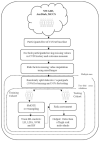Predicting Australian Adults at High Risk of Cardiovascular Disease Mortality Using Standard Risk Factors and Machine Learning
- PMID: 33808743
- PMCID: PMC8003399
- DOI: 10.3390/ijerph18063187
Predicting Australian Adults at High Risk of Cardiovascular Disease Mortality Using Standard Risk Factors and Machine Learning
Abstract
Effective cardiovascular disease (CVD) prevention relies on timely identification and intervention for individuals at risk. Conventional formula-based techniques have been demonstrated to over- or under-predict the risk of CVD in the Australian population. This study assessed the ability of machine learning models to predict CVD mortality risk in the Australian population and compare performance with the well-established Framingham model. Data is drawn from three Australian cohort studies: the North West Adelaide Health Study (NWAHS), the Australian Diabetes, Obesity, and Lifestyle study, and the Melbourne Collaborative Cohort Study (MCCS). Four machine learning models for predicting 15-year CVD mortality risk were developed and compared to the 2008 Framingham model. Machine learning models performed significantly better compared to the Framingham model when applied to the three Australian cohorts. Machine learning based models improved prediction by 2.7% to 5.2% across three Australian cohorts. In an aggregated cohort, machine learning models improved prediction by up to 5.1% (area-under-curve (AUC) 0.852, 95% CI 0.837-0.867). Net reclassification improvement (NRI) was up to 26% with machine learning models. Machine learning based models also showed improved performance when stratified by sex and diabetes status. Results suggest a potential for improving CVD risk prediction in the Australian population using machine learning models.
Keywords: artificial intelligence; cardiovascular disease; cardiovascular risk factors; clinical decision support; machine learning; risk prediction.
Conflict of interest statement
The authors declare no conflict of interest. The funders had no role in the design of the study; in the collection, analyses, or interpretation of data; in the writing of the manuscript, or in the decision to publish the results.
Figures

Similar articles
-
External validation and comparison of four cardiovascular risk prediction models with data from the Australian Diabetes, Obesity and Lifestyle study.Med J Aust. 2019 Mar;210(4):161-167. doi: 10.5694/mja2.12061. Epub 2019 Jan 18. Med J Aust. 2019. PMID: 30656697
-
Cardiovascular disease risk prediction using automated machine learning: A prospective study of 423,604 UK Biobank participants.PLoS One. 2019 May 15;14(5):e0213653. doi: 10.1371/journal.pone.0213653. eCollection 2019. PLoS One. 2019. PMID: 31091238 Free PMC article.
-
Predicting cardiovascular outcomes in Chinese patients with type 2 diabetes by combining risk factor trajectories and machine learning algorithm: a cohort study.Cardiovasc Diabetol. 2025 Feb 7;24(1):61. doi: 10.1186/s12933-025-02611-0. Cardiovasc Diabetol. 2025. PMID: 39920715 Free PMC article.
-
Performance of the Framingham risk models and pooled cohort equations for predicting 10-year risk of cardiovascular disease: a systematic review and meta-analysis.BMC Med. 2019 Jun 13;17(1):109. doi: 10.1186/s12916-019-1340-7. BMC Med. 2019. PMID: 31189462 Free PMC article.
-
Machine learning for predicting cardiac events: what does the future hold?Expert Rev Cardiovasc Ther. 2020 Feb;18(2):77-84. doi: 10.1080/14779072.2020.1732208. Epub 2020 Feb 23. Expert Rev Cardiovasc Ther. 2020. PMID: 32066289 Free PMC article. Review.
Cited by
-
Pitfalls in Developing Machine Learning Models for Predicting Cardiovascular Diseases: Challenge and Solutions.J Med Internet Res. 2024 Jul 26;26:e47645. doi: 10.2196/47645. J Med Internet Res. 2024. PMID: 38869157 Free PMC article.
-
Prediction of cardiovascular risk using machine-learning methods. Sex-specific differences.Front Cardiovasc Med. 2025 Jun 19;12:1579947. doi: 10.3389/fcvm.2025.1579947. eCollection 2025. Front Cardiovasc Med. 2025. PMID: 40612375 Free PMC article.
-
Enhanced cardiovascular risk prediction in the Western Pacific: A machine learning approach tailored to the Malaysian population.PLoS One. 2025 Jun 17;20(6):e0323949. doi: 10.1371/journal.pone.0323949. eCollection 2025. PLoS One. 2025. PMID: 40526616 Free PMC article.
-
Post-Analysis of Predictive Modeling with an Epidemiological Example.Healthcare (Basel). 2021 Jun 24;9(7):792. doi: 10.3390/healthcare9070792. Healthcare (Basel). 2021. PMID: 34202622 Free PMC article.
-
Using Machine Learning of Online Expression to Explain Recovery Trajectories: Content Analytic Approach to Studying a Substance Use Disorder Forum.J Med Internet Res. 2023 Aug 22;25:e45589. doi: 10.2196/45589. J Med Internet Res. 2023. PMID: 37606984 Free PMC article.
References
-
- Australian Institute of Health and Welfare Cardiovascular Disease. Canberra: Australian Institute of Health and Welfare. [(accessed on 15 October 2020)]; Available online: https://www.aihw.gov.au/reports/heart-stroke-vascular-diseases/cardiovas....
-
- World Health Organisation . Cardiovascular Diseases (CVDs) World Health Organisation; Geneva, Switzerland: 2017. [(accessed on 15 October 2020)]. Available online: https://www.who.int/news-room/fact-sheets/detail/cardiovascular-diseases...
-
- Damen J.A.A.G., Hooft L., Schuit E., Debray T.P.A., Collins G.S., Tzoulaki I., Lassale C.M., Siontis G.C.M., Chiocchia V., Roberts C., et al. Prediction models for cardiovascular disease risk in the general population: Systematic review. BMJ. 2016;353:i2416. doi: 10.1136/bmj.i2416. - DOI - PMC - PubMed
-
- Pylypchuk R., Wells S., Kerr A., Poppe K., Riddell T., Harwood M., Exeter D., Mehta S., Grey C., Wu B.P., et al. Cardiovascular disease risk prediction equations in 400 000 primary care patients in New Zealand: A derivation and validation study. Lancet. 2018;391:1897–1907. doi: 10.1016/S0140-6736(18)30664-0. - DOI - PubMed
Publication types
MeSH terms
LinkOut - more resources
Full Text Sources
Other Literature Sources

